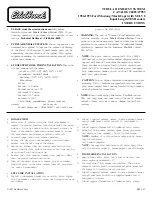
4.7.5 Terminate DC input cables
1. Identify and individually feed each DC power cable
through its respective gland then measure, cut, and
terminate with an M10 lug.
Notes:
• Depending on the site design, there may be up to two
DC+ and two DC- cables. To maintain device IP rating,
ensure that unused holes are appropriately sealed.
• Ensure that the cables sit correctly in the glands and
tighten them to ensure that no water or debris can
enter. If in doubt, use an appropriate outdoor rated
sealant .
2. Apply copper jointing compound to the mating surfaces.
3. Use an M10 spring washer and nut to fasten the cable to
the stud.
4. Tighten to 30 Nm and apply torque marks.
Figure 19: User Unit DC Termination Point
4.7.6 Terminate safety loop cable
1. Feed the safety loop cable through the gland.
Note:
If a 3-core cable is supplied only two cores are
required, the third (Earth) conductor should be taped and
stowed.
2. Strip and apply bootlaces to the cable if stranded, no
bootlace if solid core.
3. Insert the cable into the green connector on the tilt
sensor PCB, the polarity of this connection does not
matter.
Note:
This is the PCB located on the bottom-right of
4.7.3 Terminate Earthing electrode
Terminate the local earth electrode to the body of the User
Unit on the same stud as the protective Earth cable (Figure
18: User Unit Earth Stud Location).
4.7.4 Terminate Protective Earth cable
1. Identify the large protective Earth cable from the marked
cables.
2. Measure and cut to required length to terminate to stud
located in Figure 18.
Figure 18: User Unit Earth Stud Location
3. Terminate M8 lug to cable.
4. Apply green/yellow heat shrink to cable.
5. Apply aluminium jointing compound to the contact area.
6. Use an M8 spring washer and nut to fasten the cable to
the earthing stud.
7. Tighten to 16Nm and apply a torque mark.
WARNING!
• For EMC compliance, it is important that a local earthing
electrode is used to bond the chassis of the user unit
directly to ground. This may be in the form of an earth
stake, or if available, can be bonded to preexisting
buried earth structures.
• To ensure that laws and regulations are adhered to, prior
to installation of the unit, a professional review of local
lightning protection requirements must be performed.
As a result, it may be necessary to install additional
earthing electrodes for outdoor installations.
Site Installation Manual
| VersiCharge Ultra 175™ kW Fast Charger
21




































